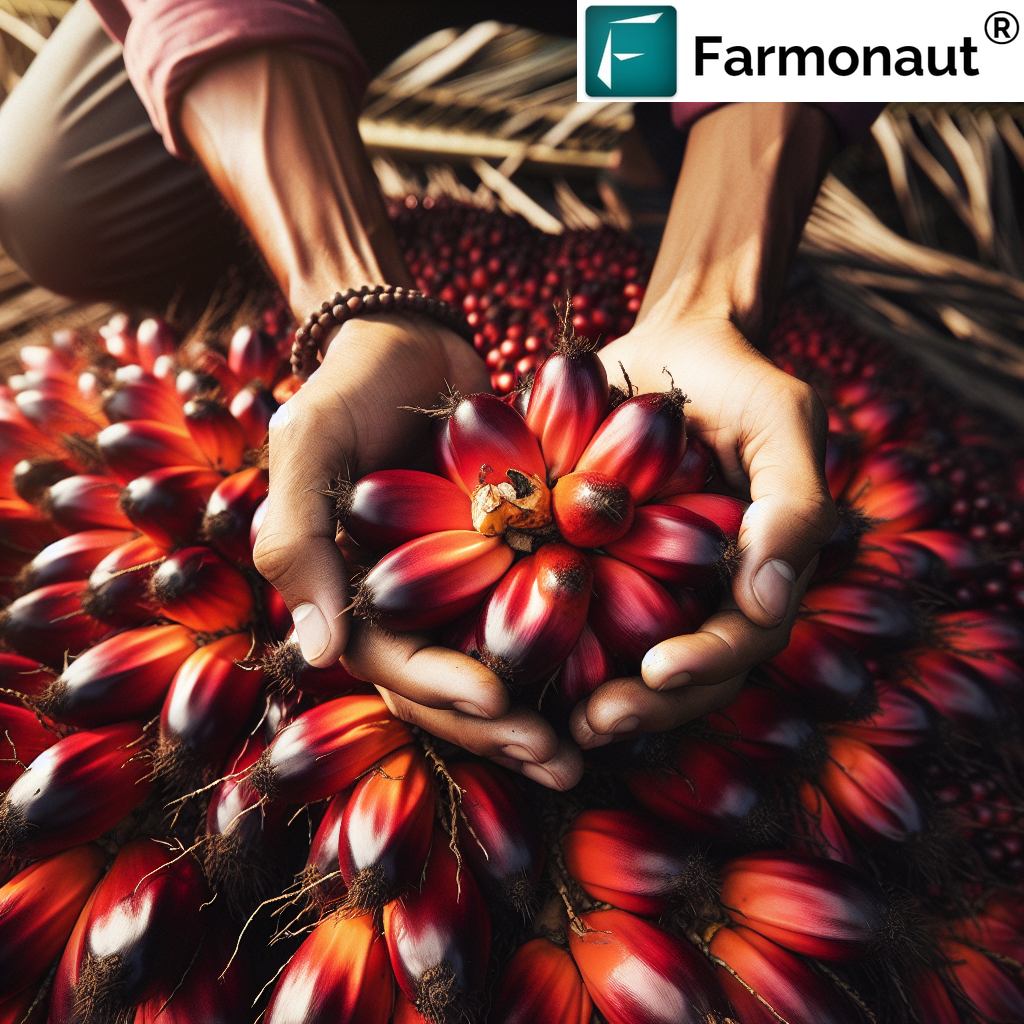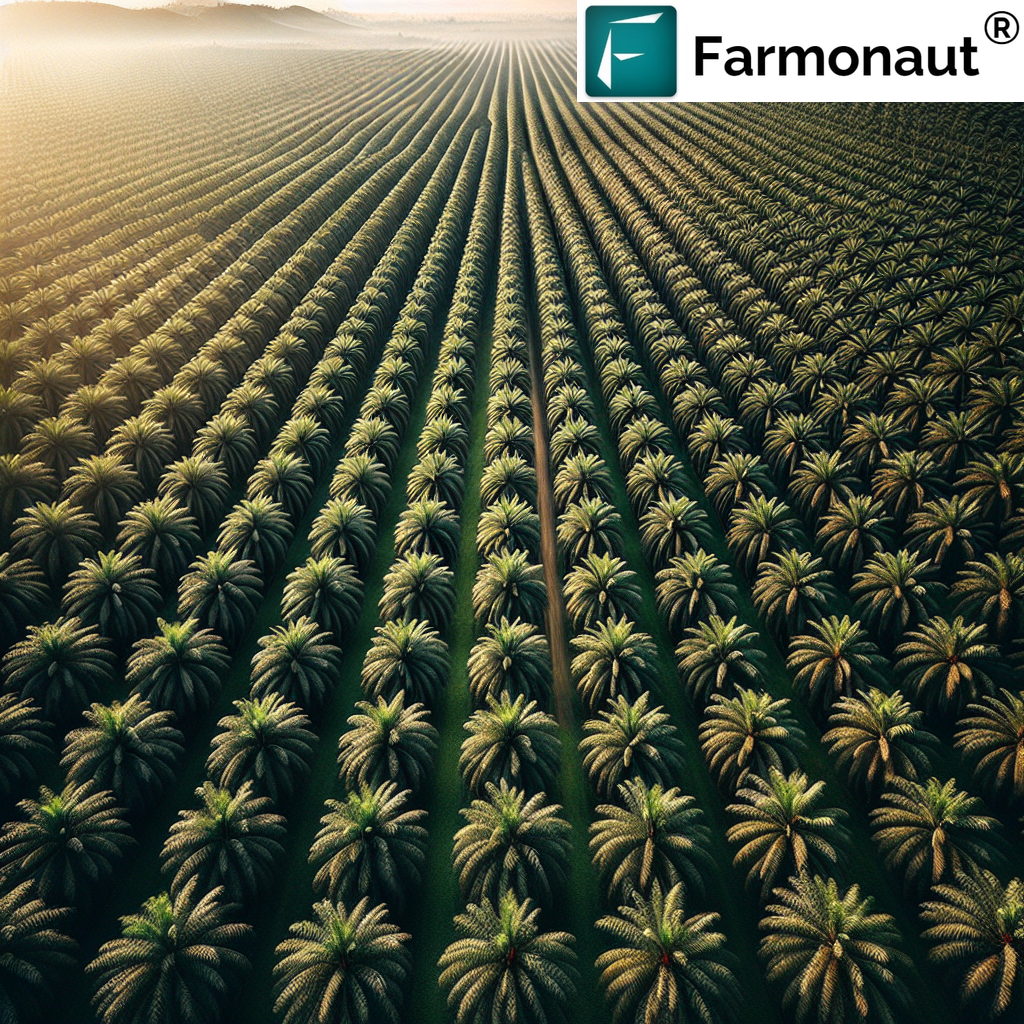Maximizing Profits: How to Establish and Manage a High-Quality Palm Oil Farm

In the ever-evolving world of agriculture, palm oil farming has emerged as a lucrative and sustainable venture. At Farmonaut, we understand the intricacies of establishing and managing a high-quality palm oil farm. In this comprehensive guide, we’ll explore the ins and outs of palm oil production, from selecting the right location to implementing cutting-edge technologies for optimal yield and sustainability.
1. Introduction to Palm Oil Farming
Palm oil is one of the most widely used vegetable oils in the world, found in everything from food products to cosmetics. The oil palm tree, scientifically known as Elaeis guineensis, is the primary source of palm oil. These oil farm trees are known for their high yield and efficiency in oil production.
Establishing a high quality palm oil farm requires careful planning, substantial investment, and a long-term commitment. However, the rewards can be significant, both financially and in terms of contributing to global food security and sustainable agriculture practices.
2. Selecting the Ideal Location for Your Oil Palm Farm
The success of your palm farm largely depends on its location. Here are key factors to consider:
- Climate: Oil palms thrive in tropical climates with consistent temperatures between 24-32°C (75-90°F).
- Rainfall: Annual rainfall of 1,800-2,000 mm, evenly distributed throughout the year, is ideal.
- Soil: Well-drained, deep, and fertile soils with a pH between 4.0 and 6.5 are optimal.
- Topography: Gently sloping or flat land is preferred for ease of management and harvesting.
- Accessibility: Proximity to transportation and processing facilities is crucial.
At Farmonaut, we offer advanced satellite-based farm management solutions that can help you assess potential locations for your oil palm farm. Our technology provides valuable insights into soil health, moisture levels, and other critical factors that influence palm oil production.
3. Establishing a High-Quality Palm Oil Farm
Once you’ve selected the ideal location, the next step is to establish your farm oil plant. This process involves several crucial steps:
- Land Preparation: Clear the land, removing existing vegetation and preparing the soil for planting.
- Seedling Selection: Choose high-yielding, disease-resistant oil palm varieties.
- Planting: Plant seedlings in a triangular pattern, typically 9 meters apart, to maximize land use.
- Irrigation System: Install an efficient irrigation system to ensure adequate water supply.
- Fertilization: Implement a comprehensive fertilization program to support healthy growth.
Our Jeevn AI Advisory System can provide personalized recommendations for each of these steps, ensuring you’re setting up your farm for success from the start.
4. Best Practices in Palm Oil Farm Management
Managing a high quality palm oil farm requires attention to detail and consistent care. Here are some best practices:
- Regular Pruning: Remove old fronds and maintain optimal leaf area for maximum photosynthesis.
- Weed Control: Implement effective weed management strategies to reduce competition for nutrients.
- Pest and Disease Management: Monitor for common pests and diseases, implementing integrated pest management strategies.
- Harvesting: Harvest ripe fruit bunches at the right time to ensure optimal oil content and quality.
- Record Keeping: Maintain detailed records of all farm activities, yields, and inputs.
Farmonaut’s satellite-based crop health monitoring system can help you keep track of your farm’s health in real-time, allowing for timely interventions and optimal management practices.
5. Sustainable Practices in Palm Oil Production
Sustainability is a crucial aspect of modern palm farm management. Here are some sustainable practices to consider:
- Zero Deforestation: Commit to not clearing primary forests for palm oil cultivation.
- Biodiversity Conservation: Maintain wildlife corridors and protect endangered species habitats.
- Water Management: Implement efficient irrigation systems and protect water sources from contamination.
- Soil Conservation: Use cover crops and implement erosion control measures.
- Community Engagement: Engage with local communities and respect indigenous land rights.
Our carbon footprinting feature can help you monitor and reduce your environmental impact, ensuring your pal oil farm operates sustainably.

6. Leveraging Technology in Palm Oil Farming
At Farmonaut, we believe that technology is key to maximizing the efficiency and sustainability of palm oil production. Here’s how our solutions can benefit your oil palm farm:
- Satellite-Based Crop Health Monitoring: Our multispectral satellite imagery provides insights into vegetation health, soil moisture levels, and other critical metrics.
- AI-Driven Advisory: Our Jeevn AI system delivers personalized farm advice based on real-time data and expert knowledge.
- Blockchain-Based Traceability: Ensure transparency in your supply chain, from farm to consumer.
- Resource Management Tools: Optimize your use of water, fertilizers, and other resources.
Here’s how Farmonaut’s Satellite System compares to drone and IoT-based farm monitoring:
| Feature | Farmonaut Satellite System | Drone-based Monitoring | IoT-based Monitoring |
|---|---|---|---|
| Coverage Area | Large scale (1000s of hectares) | Limited (10s of hectares) | Limited to sensor placement |
| Frequency of Updates | Daily to weekly | On-demand (labor-intensive) | Real-time |
| Initial Investment | Low | High | Medium to High |
| Maintenance | Minimal | Regular (equipment upkeep) | Regular (sensor maintenance) |
| Data Analysis | AI-powered, comprehensive | Requires specialized software | Limited to sensor capabilities |
7. Marketing and Selling Your Palm Oil
Successfully marketing and selling your palm oil is crucial for the profitability of your high quality palm oil farm. Consider these strategies:
- Quality Certification: Obtain relevant certifications like RSPO (Roundtable on Sustainable Palm Oil) to access premium markets.
- Direct Contracts: Establish direct contracts with food manufacturers or cosmetic companies.
- Online Marketplaces: Utilize online platforms to reach a wider customer base.
- Value-Added Products: Consider producing specialty palm oil products for niche markets.
Our blockchain-based traceability solution can help you demonstrate the quality and sustainability of your palm oil to potential buyers, giving you a competitive edge in the market.
8. Challenges and Solutions in Palm Oil Farming
While palm oil farming can be highly profitable, it’s not without its challenges. Here are some common issues and how to address them:
- Price Volatility: Diversify your market and consider futures contracts to mitigate price risks.
- Environmental Concerns: Implement and showcase sustainable farming practices.
- Labor Shortages: Invest in mechanization and efficient harvesting techniques.
- Disease Outbreaks: Use resistant varieties and implement comprehensive pest management strategies.
Our AI-driven advisory system can help you anticipate and prepare for these challenges, ensuring the long-term success of your oil palm farm.
9. The Future of Palm Oil Farming
The future of palm oil farming is bright, with increasing global demand and advancements in sustainable production techniques. Key trends to watch include:
- Precision Agriculture: Increased use of data-driven farming techniques for optimal resource use.
- Sustainable Intensification: Producing more oil on existing farmland through improved practices and varieties.
- Biodiversity Integration: Developing palm oil production systems that support local ecosystems.
- Alternative Uses: Exploring new applications for palm oil in biofuels and other industries.
At Farmonaut, we’re committed to staying at the forefront of these trends, continually updating our technology to support the evolving needs of palm oil farmers.
10. FAQs
Q: How long does it take for oil palm trees to start producing fruit?
A: Oil palm trees typically start producing fruit 3-4 years after planting, with peak production occurring between 7-18 years.
Q: What is the average lifespan of an oil palm tree?
A: Oil palm trees can live for up to 25-30 years, but their economic lifespan is usually around 20-25 years due to decreasing yield and increasing harvesting difficulty.
Q: How much land is needed to start a profitable palm oil farm?
A: While this can vary, a minimum of 50-100 hectares is often considered necessary for a commercially viable operation.
Q: What is the yield of a well-managed oil palm farm?
A: A well-managed farm can yield 20-30 tons of fresh fruit bunches per hectare per year, which translates to about 4-6 tons of crude palm oil.
Q: How can I ensure my palm oil farm is environmentally sustainable?
A: Implement best practices such as zero deforestation, biodiversity conservation, and efficient resource use. Consider obtaining RSPO certification to validate your sustainable practices.
Conclusion
Establishing and managing a high quality palm oil farm is a complex but rewarding endeavor. By leveraging advanced technologies like those offered by Farmonaut, you can optimize your farm’s productivity, sustainability, and profitability. From satellite-based crop monitoring to AI-driven advisory systems, our solutions are designed to support palm oil farmers at every stage of their journey.
Ready to take your palm oil farm to the next level? Explore our services:
- Try our mobile app
- Access our API
- Download on Google Play
- Download on the App Store
- Explore our API documentation
Subscribe to Farmonaut’s services to unlock the full potential of your palm oil farm:
With the right approach and tools, your palm oil farm can thrive, contributing to both your success and sustainable agricultural practices worldwide.